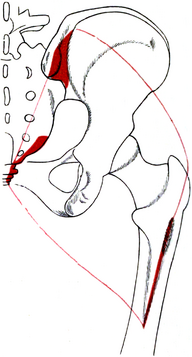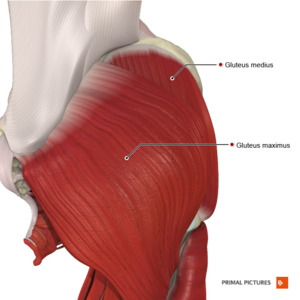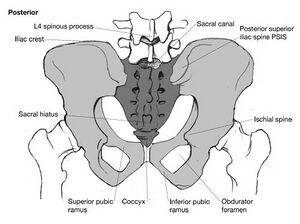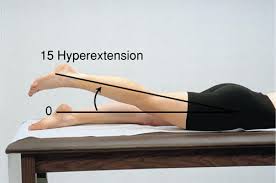Gluteus Maximus: Difference between revisions
No edit summary |
No edit summary |
||
| Line 69: | Line 69: | ||
# Sedentary life style and not doing sports since all the work will be done by hamstring as an Energy conservative mechanism of the body to save Glutes maximus for hard activities as running, raising stairs ,etc .So not doing sports won`t engage your Glutes maximus and increase it`s inhibition and making hamstring to take over it`s action and becomes synergistic dominant. | # Sedentary life style and not doing sports since all the work will be done by hamstring as an Energy conservative mechanism of the body to save Glutes maximus for hard activities as running, raising stairs ,etc .So not doing sports won`t engage your Glutes maximus and increase it`s inhibition and making hamstring to take over it`s action and becomes synergistic dominant. | ||
All these causes will not only affect the timing of the Glutes maximus but also will affect the amplitude of activation of Glutes maximus<ref>Arab ِA M, Ghamkhar L, Emami M , Nourbakhsh M R. [https://chiromt.biomedcentral.com/articles/10.1186/2045-709X-19-18 Altered muscular activation during prone hip extension in women with and without low back pain] .CHIROPRACTIC & MANUAL THERAPIES.2011.19_18 .</ref> | All these causes will not only affect the timing of the Glutes maximus but also will affect the amplitude of activation of Glutes maximus<ref>Arab ِA M, Ghamkhar L, Emami M , Nourbakhsh M R. [https://chiromt.biomedcentral.com/articles/10.1186/2045-709X-19-18 Altered muscular activation during prone hip extension in women with and without low back pain] .CHIROPRACTIC & MANUAL THERAPIES.2011.19_18 .</ref> | ||
This 9 minute video is titled: Learn the difference between true muscular weakness and muscular inhibition. Most therapists and trainers will claim to find weak glutes when in reality they are finding inhibited glutes. | |||
{{#ev:youtube|YtIhkWqciyc|400}} | {{#ev:youtube|YtIhkWqciyc|400}} | ||
=== Activation of Glutes maximus === | === Activation of Glutes maximus === | ||
| Line 119: | Line 121: | ||
=== Palpation === | === Palpation === | ||
[[File:Pelvis landmarks.jpeg|right|frameless]] | |||
Locate the iliac crest then move posterior along the crest to a small bony process called the posterior superior illac spine (PSIS). Place the palm of your hand with fingers pointing down and towards the mid line of the body. The upper hand now covers the origin attachments and under the palm is the bulk of gluteus maximus. | Locate the iliac crest then move posterior along the crest to a small bony process called the [[Pelvic Landmarks|posterior superior illac spine (PSIS).]] Place the palm of your hand with fingers pointing down and towards the mid line of the body. The upper hand now covers the origin attachments and under the palm is the bulk of gluteus maximus. | ||
Contraction of the muscle can confirm this. Gluteus maximus can be palpated whilst it acts during standing hip extension, a step-up, or whilst standing raise the medial borders of the foot.<ref name="pala" /> | Contraction of the muscle can confirm this. Gluteus maximus can be palpated whilst it acts during standing hip extension, a step-up, or whilst standing raise the medial borders of the foot.<ref name="pala" /> | ||
| Line 129: | Line 131: | ||
=== Power === | === Power === | ||
*Hip extension in prone | *[[File:Hip ext rom.jpg|right|frameless]]Hip extension in prone | ||
*[https://www.youtube.com/watch?v=Iycq-kJann0 Body weight good morning] | *[https://www.youtube.com/watch?v=Iycq-kJann0 Body weight good morning] | ||
*Step up | *Step up | ||
| Line 138: | Line 140: | ||
== Treatment == | == Treatment == | ||
You should first search for the | You should first search for the cause of the Glutes maximus inhibition in your patient. Then try to solve this problem,Then begin by activation of your Glutes maximus gradually and progressively as mentioned in the Activation exercises above . | ||
== | == Relevant Videos == | ||
{| width="100%" cellspacing="1" cellpadding="1" | {| width="100%" cellspacing="1" cellpadding="1" | ||
|- | |- | ||
| Line 153: | Line 155: | ||
== See also == | == See also == | ||
A selection of physiopedia pages, others also exist, try the search bar. | |||
*[[Gluteus Medius|Gluteus medius]] | *[[Gluteus Medius|Gluteus medius]] | ||
*[[Lower Crossed Syndrome|Lower crossed syndrome]] | *[[Lower Crossed Syndrome|Lower crossed syndrome]] | ||
*[[Ober's Test|Ober's test]] | *[[Ober's Test|Ober's test]] | ||
*[[Gluteal Muscles]] | |||
== References == | == References == | ||
Revision as of 11:54, 12 January 2022
Original Editor - Joanne Garvey
Top Contributors - George Prudden, Joanne Garvey, Kim Jackson, Ahmed Nasr, Lucinda hampton, Admin, Rachael Lowe, Joao Costa, Khloud Shreif, Richard Benes, Sai Kripa, Wendy Walker, Evan Thomas, WikiSysop, Kai A. Sigel and Candace Goh
Description[edit | edit source]
Gluteus Maximus the largest and heaviest muscle in the body. It is the most superficial of all gluteal muscles that are located at the posterior aspect of the hip joint. It is the largest muscle at the hip representing 16% of the total cross-sectional area.[1][2][3]
Gluteus Maximus's size allows it to generate a large amount of force (the muscle evolved from an adductor of the hip which is still seen in lower primates today). The development of the muscle's function is associated with the erect posture and changes to the pelvis, now functioning to maintain the erect posture, as a hip extensor.[4]
- Gluteus maximus covers all of the gluteal muscles except for the antero_superior third of the Glutes medius.
- The ischial tuberosity can be felt deep to the lower part of the Glutes maximus. When the thigh is flexed the lower border of Glutes Maximus moves superiorly , exposing the ischial tuberosit subcutaneously (in sitting you sit on the ishial tuberosity , ischial bursae , subcutaneous fat and skin).[1]
Anatomy[edit | edit source]
Origin
- Outer slope of the dorsal segment of the iliac crest
- Gluteal surface of ilium
- Dorsal surface of lower part of the sacrum
- Side of coccyx
- Sacrotuberous ligament
- Gluteal aponeurosis . [5]
- Attaches to thoracolumbar fascia and its associated raphe. By this attachment Glutes maximus is coupled to the ipsilateral multifidus and contralateral Latissimus dorsi forming posterior oblique and deep longitudinal myofascial slings you can read more in details of these in the Anatomy Slings and Their Relationship to Low Back Pain.[3]
Image 2: Gluteus maximus of right side - outline and attachment-areas.
Insertion
- Gluteal tuberosity
- Iliotibial tract[6]
Nerve supply
The gluteus maximus is supplied by the inferior gluteal nerve (root L5, S1 and S2). Cutaneous supply is mainly provided by L2 and 3.[4]
Image 3: Gluteus maximus and minimus.
Anatomy Overview - Video
Function[edit | edit source]
- Chief extensor of the thigh
- Essential for maintaining an erect posture
- Lateral rotation of the thigh
- Abduction of the thigh
Role in ADLs eg:
- As a powerful extensor of the hip joint, the gluteus maximus suited to powerful lower limb movements eg stepping onto a step, climbing or running but is not used greatly during normal walking.
- Gluteus maximus and the hamstrings work together to extend the trunk from a flexed position by pulling the pelvis backwards,eg standing up from a bent forward position. Eccentric control is also provided when bending forward.[3]
- If the gluteus maximus is paralyzed climbing stairs and running will become very difficult however, other muscles can extend the hip. Gluteus maximus can be trained to produce functional knee extension when quadriceps femoris is weak or paralyzed.[4]
- Research has indicated that contraction of the deep abdominal muscles may assist with the contraction of gluteus maximus to assist with the control of anterior pelvic rotation.[7] Gluteal muscle weakness has been proposed to be associated with a number of lower limb injuries.[8]
Clinical Relevance[edit | edit source]
Gluteus maximus is one of the strongest muscle in the human body. It works with the semitendinoses and semimembranoses to extend the hip. When paralysis of gluteus maximus occurs, the person feels difficulty to stand up from the sitting posture without the support. The gluteus maximus paralysis is more obvious in case of muscular dystrophy. The gower's sign is positive on physical examination which is commonly observed due to the weakness of proximal hip muscles. In such a condition, the child feels difficulty to stand up due to which he/she places their hands on legs for support and then on the thighs which help the child to climb on themselves.[9]
Inhibition of Glutes maximus[edit | edit source]
As mentioned by vladmir janda`s Glutes maximus is one of phasic muscles that tends to be inhibited in our body by many causes :[10]:
- Arthrogenic inhibition from the hip joint .[11]
- Tight iliopsosas which sends a reciprocal inhibition to Glutes maximus as in Posterior lower crossed syndrome. [12]
- Pain reflex inhibition either hip pain or lumbopelvic pain.
- Stretched weakness of Glutes maximus .
- Sedentary life style and not doing sports since all the work will be done by hamstring as an Energy conservative mechanism of the body to save Glutes maximus for hard activities as running, raising stairs ,etc .So not doing sports won`t engage your Glutes maximus and increase it`s inhibition and making hamstring to take over it`s action and becomes synergistic dominant.
All these causes will not only affect the timing of the Glutes maximus but also will affect the amplitude of activation of Glutes maximus[13]
This 9 minute video is titled: Learn the difference between true muscular weakness and muscular inhibition. Most therapists and trainers will claim to find weak glutes when in reality they are finding inhibited glutes.
Activation of Glutes maximus[edit | edit source]
There are many exercises that help in activation of Glutes maximus each exercise activate Glutes maximus by a certain percentage as shown by EMG activity. We divide them as following[2] :
| Level of activation of Glutes maximus | Type of exercises |
|---|---|
| Low level of activation (0_20%MVIC) |
|
| Moderate-level activation (21–40% MVIC) |
|
| High-level activation (41–60% MVIC) |
|
| Very high-level activation (>60% MVIC) |
|
- MVIC = maximum voluntary isometric contraction
N.B The prone bridge/plank are unique from the other exercises in the low-level activation because of it`s static nature to maintain
a neutral hip and spine position during this exercise. The low-level activation (9%MVIC)exercises group are most likely reflected the GMax’s role as a hip and spine stabilizer.
Assessment[edit | edit source]
Palpation[edit | edit source]
Locate the iliac crest then move posterior along the crest to a small bony process called the posterior superior illac spine (PSIS). Place the palm of your hand with fingers pointing down and towards the mid line of the body. The upper hand now covers the origin attachments and under the palm is the bulk of gluteus maximus.
Contraction of the muscle can confirm this. Gluteus maximus can be palpated whilst it acts during standing hip extension, a step-up, or whilst standing raise the medial borders of the foot.[4]
Evaluation of movement pattern[edit | edit source]
Hip extension movement pattern [10]
Power[edit | edit source]
- Hip extension in prone
- Body weight good morning
- Step up
- Functional tasks (steps, etc.)
Treatment[edit | edit source]
You should first search for the cause of the Glutes maximus inhibition in your patient. Then try to solve this problem,Then begin by activation of your Glutes maximus gradually and progressively as mentioned in the Activation exercises above .
Relevant Videos[edit | edit source]
See also[edit | edit source]
A selection of physiopedia pages, others also exist, try the search bar.
References[edit | edit source]
- ↑ 1.0 1.1 Keith L. , Anne M. R . Clinically Oriented Anatomy . philidephia : Lippincott Williams & Wilkins.Feb 13, 2013
- ↑ 2.0 2.1 Reiman MP , Bolgla LA, Loudon JK. A literature review of studies evaluating gluteus maximus and gluteus medius activation during rehabilitation exercises. Physiotherapy Theory and Practice. 2012 :28(4): 257-268.
- ↑ 3.0 3.1 3.2 Vleeming A ,Mooney V . Movement, Stability & Lumbopelvic Pain 2nd Edition . Philadelphia.Churchill Livingstone .1st March 2007
- ↑ 4.0 4.1 4.2 4.3 Palastanga N, Soames R. Anatomy and Human Movement: Structure and Function. 6th ed. London, United Kingdom: Churchill Livingstone . 2012.
- ↑ Kendall F.B , McCreary E.K ,Provance P.G .Muscles: Testing and Function, with Posture and Pain (Kendall, Muscles) Fifth, North American Edition. Philadelphia. Lippincott Williams & Wilkins, 2005.
- ↑ Anatomy info Gluteal muscles Available: https://anatomyinfo.com/gluteal-muscles/ (accessed 12.1.2022)
- ↑ Kim TW, Kim YW.Effects of abdominal drawing-in during prone hip extension on the muscle activities of the hamstring, gluteus maximus, and lumbar erector spinae in subjects with lumbar hyperlordosis; J Phys Ther Sci. 2015 Feb : 27(2):383-6.
- ↑ Distefano LJ, Blackburn JT, Marshall SW, Padua DA. Gluteal muscle activation during common therapeutic exercises. J Orthop Sports Phys Ther. 2009 Jul :39(7):532-40
- ↑ Chaurasia BD. Human Anatomy Lower Limb Abdomen and Pelvis. Vol 2. CBS Publishers and Distributors Pvt Ltd, 2010
- ↑ 10.0 10.1 Page .P, Frank C, Lardner R. Assessment and Treatment of Muscle Imbalance: The Janda Approach .Champaign . Human Kinetics. 2010.
- ↑ Freeman S, Mascia A, McGill S. Arthrogenic neuromusculature inhibition: a foundational investigation of existence in the hip joint.Clinical Biomechanics .February 2013:28(2):171–177.
- ↑ Josephine Key. A Movement Problem E-Book: A clinical approach incorporating relevant research and practice 1st Edition .Edinburgh .New York .Churchill Livingstone ELSEVIER.2010
- ↑ Arab ِA M, Ghamkhar L, Emami M , Nourbakhsh M R. Altered muscular activation during prone hip extension in women with and without low back pain .CHIROPRACTIC & MANUAL THERAPIES.2011.19_18 .











